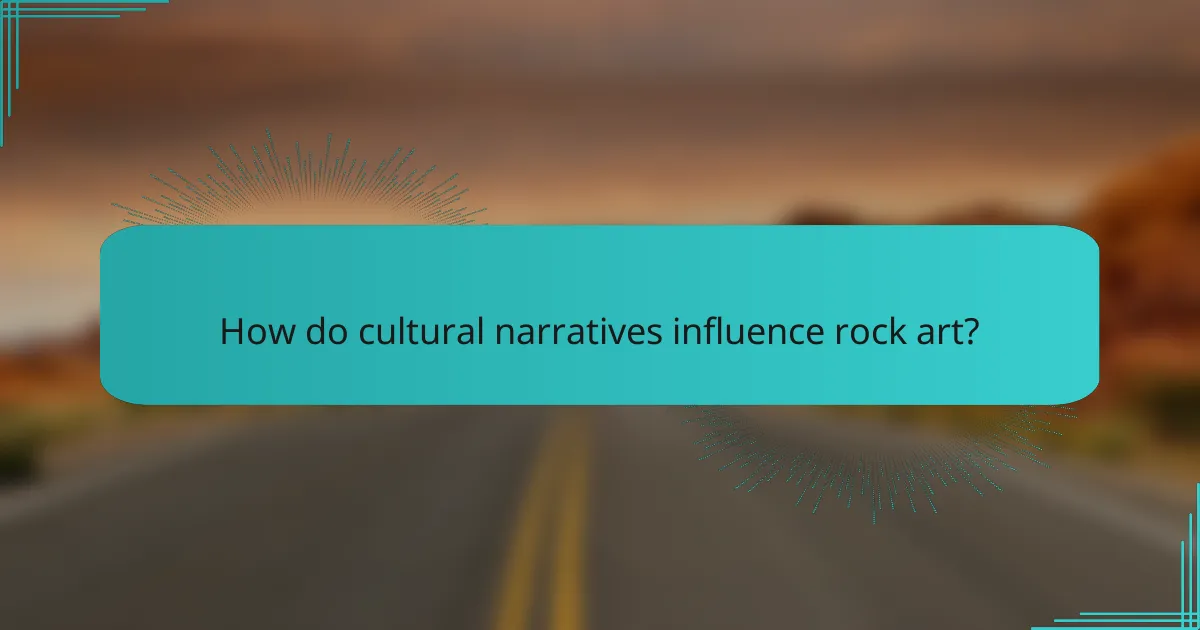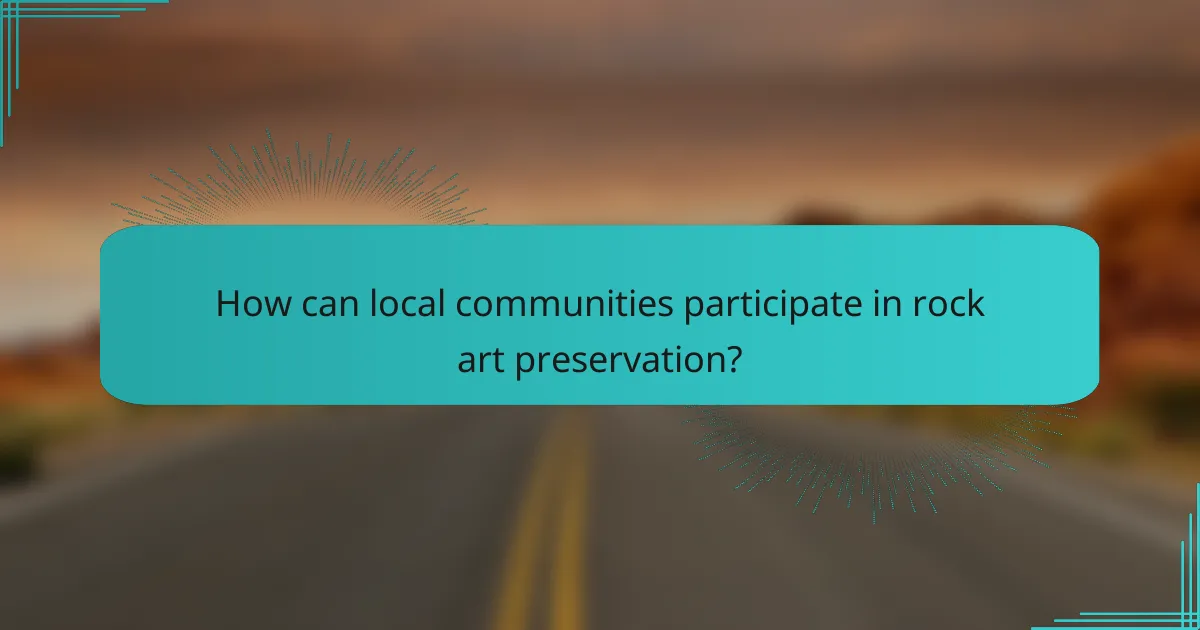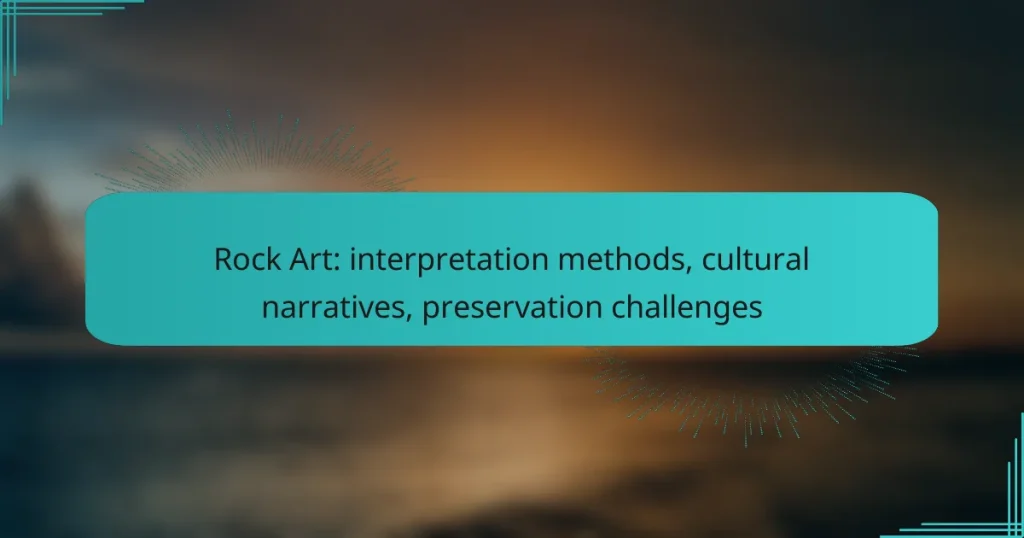Rock art serves as a vital window into the cultural narratives of ancient societies, revealing their beliefs, values, and historical experiences. Various interpretation methods, such as iconographic and contextual analysis, help uncover the significance of these artworks, while preservation challenges, including environmental threats and human impact, threaten their longevity. Understanding and protecting these cultural artifacts is essential for appreciating the rich heritage they represent.

What are the interpretation methods for rock art?
Interpretation methods for rock art involve various analytical techniques aimed at understanding the meaning, context, and significance of these ancient artworks. These methods include iconographic analysis, contextual analysis, comparative studies, ethnographic approaches, and technological imaging, each offering unique insights into the cultural narratives behind the art.
Iconographic analysis
Iconographic analysis focuses on the symbols and imagery present in rock art, interpreting their meanings based on established visual motifs. This method often requires familiarity with cultural symbolism and can involve cross-referencing with other art forms to identify recurring themes.
For instance, a motif of a bison may signify abundance or hunting prowess in certain cultures. Researchers often compile catalogs of symbols to aid in this analysis, which can help in understanding the broader narrative of a community.
Contextual analysis
Contextual analysis examines the physical and cultural environment surrounding rock art sites to derive meaning. This includes studying the location, associated artifacts, and the geological features of the area, which can provide clues about the purpose and significance of the artwork.
For example, rock art found near water sources may indicate rituals related to fertility or sustenance. Understanding the context helps researchers grasp how the art relates to the daily lives and beliefs of the people who created it.
Comparative studies
Comparative studies involve analyzing rock art across different cultures or geographical areas to identify similarities and differences. This method can reveal patterns of cultural exchange or influence, as well as distinct regional characteristics.
By comparing motifs, styles, and techniques, researchers can trace the evolution of artistic practices and understand how various communities interacted over time. This approach often highlights the shared human experience reflected in rock art.
Ethnographic approaches
Ethnographic approaches incorporate fieldwork and interviews with contemporary Indigenous communities to gain insights into the meanings and uses of rock art. This method emphasizes the importance of oral traditions and cultural narratives that inform the interpretation of the art.
Engaging with local communities can uncover stories and practices that have persisted over generations, providing a living context for the rock art. Researchers must approach this method with sensitivity and respect for cultural heritage.
Technological imaging
Technological imaging employs advanced tools such as 3D scanning, infrared photography, and digital enhancement to analyze rock art more deeply. These technologies can reveal details that are not visible to the naked eye, such as underlying layers or faded elements.
For example, 3D models can help visualize the spatial relationships of artworks within their environment, while infrared imaging can uncover hidden designs. This method enhances traditional analysis and can lead to new discoveries about the techniques and intentions of ancient artists.

How do cultural narratives influence rock art?
Cultural narratives significantly shape rock art by providing context and meaning to the images created by various societies. These narratives reflect the beliefs, values, and historical experiences of the people, influencing how they express themselves through art.
Storytelling traditions
Storytelling traditions are integral to rock art, as they often serve as a medium for passing down knowledge and cultural values. Many rock art sites depict scenes from oral histories, illustrating myths or legends that define a community’s identity. For instance, Indigenous Australian rock art frequently tells Dreamtime stories that explain the creation of the land and its inhabitants.
These narratives can vary widely, with some cultures using symbolic imagery to convey complex stories. Understanding these traditions is crucial for interpreting the artwork accurately, as each symbol may hold specific meanings tied to the community’s history.
Spiritual beliefs
Spiritual beliefs play a vital role in the creation and interpretation of rock art. Many cultures view rock art as a connection to the spiritual world, using it to communicate with ancestors or deities. For example, Native American rock art often features motifs believed to invoke protection or blessings from spiritual beings.
These spiritual connections can influence the choice of colors, materials, and techniques used in the artwork. Recognizing the spiritual significance can enhance appreciation and understanding of the rock art, as well as inform preservation efforts that respect these beliefs.
Historical context
The historical context surrounding rock art is essential for understanding its significance. Changes in environment, migration patterns, and social structures can all impact the themes and styles of rock art. For instance, rock art from the Sahara Desert reflects the region’s transition from a lush landscape to a more arid environment, showcasing the adaptation of its inhabitants.
Additionally, historical events such as colonization or conflict can alter the meaning of existing rock art or inspire new creations. Documenting these contexts is crucial for preserving the art and ensuring that future generations understand its relevance and history.

What are the preservation challenges for rock art in Canada?
Preservation challenges for rock art in Canada include environmental threats, human impact, and funding limitations. These factors significantly affect the longevity and integrity of these cultural artifacts.
Environmental threats
Environmental threats to rock art in Canada primarily stem from natural elements such as weathering, erosion, and climate change. Increased rainfall and temperature fluctuations can accelerate the deterioration of rock surfaces, leading to the loss of intricate designs.
Additionally, invasive plant species can encroach on rock art sites, causing physical damage and obscuring visibility. Protecting these sites from environmental degradation requires ongoing monitoring and adaptive management strategies.
Human impact
Human activities pose significant risks to rock art, including vandalism, graffiti, and unregulated tourism. Visitors may unintentionally damage these sites through physical contact or by leaving behind litter, which can alter the natural landscape.
To mitigate human impact, education and awareness campaigns are essential. Local communities and authorities should promote responsible tourism practices and establish guidelines to protect these cultural treasures.
Funding limitations
Funding limitations hinder the preservation of rock art in Canada, as many sites lack adequate financial resources for conservation efforts. Government grants and private donations are often insufficient to cover the costs of restoration and maintenance.
To address funding challenges, partnerships between government agencies, Indigenous communities, and non-profit organizations can be beneficial. Collaborative efforts can help secure resources and ensure that preservation initiatives are sustainable and effective.

What criteria should be used for selecting preservation methods?
Preservation methods for rock art should be selected based on their material compatibility, long-term sustainability, and community involvement. These criteria ensure that the chosen methods effectively protect the artwork while respecting cultural narratives and local contexts.
Material compatibility
When selecting preservation methods, it’s crucial to consider the materials used in the rock art itself. Techniques and materials that are chemically or physically compatible with the original artwork will minimize damage and degradation. For example, using breathable coatings can protect the surface without trapping moisture, which could lead to deterioration.
Conducting a thorough analysis of the rock substrate and the pigments used can guide the choice of preservation materials. Avoiding harsh chemicals or abrasive methods is essential to maintain the integrity of the art.
Long-term sustainability
Long-term sustainability involves selecting preservation methods that will remain effective over time without requiring frequent intervention. This can include using natural materials that blend with the environment and withstand weathering. For instance, biodegradable sealants can offer protection while being environmentally friendly.
It’s important to assess the potential impact of climate change on rock art sites. Preservation strategies should be adaptable to changing environmental conditions, ensuring that they remain effective for decades or longer.
Community involvement
Engaging local communities in the preservation process is vital for the success of any preservation method. Community members often have valuable insights into the cultural significance of the rock art and can help monitor and maintain the site. This involvement fosters a sense of ownership and responsibility towards the preservation efforts.
Workshops and educational programs can empower local populations to participate actively in preservation. Collaborating with indigenous groups can also ensure that traditional knowledge and practices are respected and integrated into preservation strategies.

What are the emerging trends in rock art research?
Emerging trends in rock art research focus on innovative preservation methods, interdisciplinary approaches, and enhanced public involvement. These trends aim to deepen our understanding of cultural narratives while addressing the challenges of preserving these ancient artworks.
Digital preservation techniques
Digital preservation techniques involve using advanced technologies to document and protect rock art. Methods such as 3D scanning, photogrammetry, and digital imaging allow researchers to create detailed records of rock art sites, which can be shared and analyzed without physical contact.
These techniques help mitigate deterioration caused by environmental factors and human activity. For example, creating high-resolution digital archives can facilitate remote access for researchers and the public, ensuring that the art remains accessible even if the original sites are compromised.
Interdisciplinary collaborations
Interdisciplinary collaborations are becoming essential in rock art research, bringing together experts from fields such as archaeology, anthropology, geology, and digital technology. This diverse expertise fosters a more comprehensive understanding of the cultural and historical contexts of rock art.
Collaborative projects can lead to innovative solutions for preservation and interpretation. For instance, partnerships between scientists and indigenous communities can enhance the cultural narratives surrounding rock art, ensuring that traditional knowledge informs modern research practices.
Increased public engagement
Increased public engagement in rock art research is crucial for raising awareness and appreciation of these cultural treasures. Initiatives such as community workshops, educational programs, and interactive exhibitions encourage local involvement and stewardship of rock art sites.
By fostering a sense of ownership and responsibility, these programs help protect rock art from vandalism and environmental threats. Engaging the public also promotes a deeper understanding of the significance of rock art, encouraging ongoing support for preservation efforts.

How can local communities participate in rock art preservation?
Local communities can play a vital role in rock art preservation by engaging in stewardship, education, and advocacy efforts. Their involvement ensures that cultural narratives are respected and that preservation practices are sustainable and culturally appropriate.
Community Education and Awareness
Educating community members about the significance of rock art is essential for preservation. Workshops, school programs, and community events can raise awareness about the cultural and historical importance of these sites. Engaging local artists to interpret and share their perspectives can further enrich understanding.
Collaborative Preservation Efforts
Collaboration between local communities, archaeologists, and conservationists can lead to effective preservation strategies. Establishing partnerships allows for shared resources and knowledge, ensuring that preservation methods align with community values. Regular meetings can help maintain open communication and adapt strategies as needed.
Advocacy for Legal Protections
Local communities can advocate for legal protections that safeguard rock art sites from vandalism and development. This may involve lobbying for local, national, or international designations that recognize the cultural significance of these sites. Engaging with policymakers can amplify community voices in preservation efforts.
Monitoring and Maintenance
Communities can take an active role in monitoring rock art sites for signs of deterioration or damage. Establishing a volunteer group to regularly inspect sites can help identify issues early. Simple maintenance tasks, like cleaning or reporting vandalism, can significantly contribute to the longevity of these cultural treasures.


